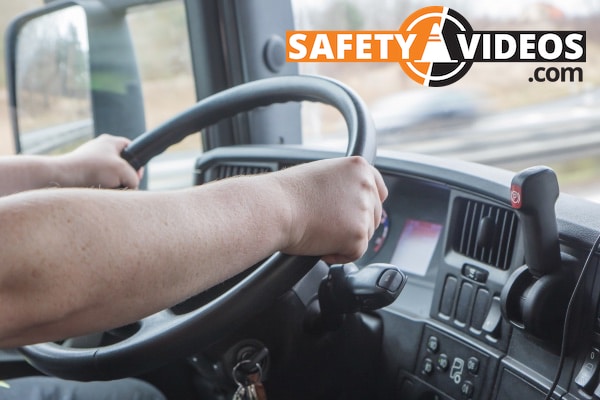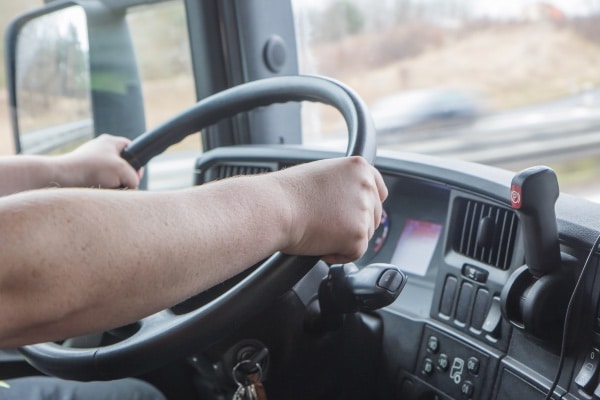Personal Conveyance Rules – [Full Guide – Updated for 2024]

Personal conveyance regulations established by the FMCSA can be tricky to understand, especially if you’re new to operating a commercial motor vehicle, referred often by the abbreviation (CMV). However, in this guide, you’ll learn all about the personal conveyance rules to meet compliance and avoid penalties.
Read below to understand better personal conveyance rules, who must comply, and how they apply. Also, we do have an Hours of Service training program you should check out as well.
Why Personal Conveyance Matters
You’re not the only one wondering if particular movements made with a CMV are considered personal conveyance. Personal conveyance, or the operation of a CMV for personal use while off duty, has been a point of contention for motor carriers and truck drivers since the electronic logging device or ELD was implemented in addition to Hours of Service (HOS) rules established by the Federal Motor Carrier Safety Administration (FMCSA).
The regulations covered in this guide constitute a significant change from how driving was regulated before implementing the ELD for passenger-carrying CMVs. Hours of service were manually tracked using a paper log, making it difficult for the Department of Transportation (DOT) to enforce such regulations.
Drivers could use their CMV for personal conveyance purposes whenever they wanted, and no one would know. (If you are still using paper logbooks, we have a full guide on filling out the DOT paper logbooks that you should check out.)
With these rules put in place, however, the ELD will record all moves with a CMV, including a driver’s on-duty time. This requirement has made it difficult for drivers to understand how to differentiate when the trailer is being rightfully used for personal conveyance.

What Are Personal Conveyance Rules?
Personal conveyance rules are rules established by the Federal Motor Carrier Safety Administration (FMCS). They require truck drivers to document their hours of service by identifying which duty status they are working under while driving. The different statuses include:
- On-duty not driving
- Driving
- Sleeper berth
- Off duty
- Personal conveyance refers to using a commercial motor vehicle (CMV) for personal use while off duty.
Who Has to Follow Personal Conveyance Rules?
Personal conveyance rules apply to those who operate commercial motor vehicles (CMVs). According to the FMCS, a CMV is a self-propelled or towed unit that is used for interstate commerce to transport people or property definable by these categories:
- Gross vehicle weight or gross combination of 10,000 pounds
- Gross vehicle weight rating or gross combination of over 10,000 pounds
- Can carry 8 or more people (including the driver) for compensation
- Can carry 16 or more people (including the driver) for compensation
- It transports hazardous materials and has been identified by the Secretary of Transportation.
It’s every driver and carrier’s responsibility to operate a Commercial Motor Vehicle safely in these situations. All of these guidelines need to be followed by all commercial motor vehicle drivers who use personal conveyance.

How to Determine if You’re Following Personal Conveyance Rules
As a truck driver, it shouldn’t be difficult to determine if you’re following personal conveyance rules. One of the easiest ways to establish personal conveyance limitations is to answer several questions. These questions should include:
- Am I considered off-duty right now?
- Am I currently doing work for a motor carrier or for myself?
- Is the vehicle being moved for personal reasons?
- Is this for a non-business purpose?
If you answer yes to all of these questions, you are operating under personal conveyance. The vehicle can always be used for personal conveyance, even when the load is still on the vehicle, as long as the load is not being transported for commercial benefit.
What Can Personal Conveyance Be Used For?
Drivers operating a CMV for personal conveyance can record their driving time as off-duty only if they have been relieved from work and have completed all of their assigned responsibilities. Personal conveyance doesn’t reduce a driver or motor carrier’s responsibility to operate a CMV safely.
A safety official can have drivers using personal conveyance other off-duty drivers to move their CMVs to rest locations for a required rest that is within reason to their scheduled motor carrier destination. That is, as long as they do not pass the nearest one to be as close as possible for operational readiness.
This includes a hotel, truck stop, or even a location for vehicle maintenance if they need to make a pitstop on the way to the motor carrier’s terminal.
The time spent transporting personal property or driving to entertainment facilities, cargo trailer drop lots, and transporting others when considered off-duty drivers are all permissible. However, that’s only if the actions are taken for commercial benefit.
There are many ways that personal conveyance can be spent as long as the motor carrier isn’t prohibiting personal conveyance. In this case, it would still be important to understand the examples of personal conveyance, even if you cannot use it due to the restrictions.
Examples that Qualify as Personal Conveyance
These are some examples that qualify as personal conveyance:
- Time spent commuting from work to home. This includes commuting time between the driver’s terminal, drop lots, and worksites or residences.
- Time spent traveling from a motel or truck stops en route lodging to commercial facilities while off duty. This includes restaurants, entertainment facilities, and other locations.
- Moving a CMV per the request of a safety official while off duty.
- Time spent transporting personal property while off duty.
- Commuting to another location for rest, such as a truck stop or other safe location after loading or unloading.
- Traveling back home after work to another location off-site.
- Commuting between the driver’s residence and between work sites and their residence. This can include a trip to obtain the required rest.

Examples That Don’t Qualify as Personal Conveyance
These are some examples that don’t qualify as personal conveyance:
- Moving a CMV to improve a motor carrier’s operational readiness. This includes passing by available resting locations or en route lodging to stop at one closest to the next loading or unloading point.
- Picking up another towed unit after completing a delivery under the guidance of a motor carrier. After making the delivery, the truck no longer meets the definition of CMV.
- Operating a motorcoach carrying luggage for passengers who have already gotten out.
- Time spent traveling to get vehicle maintenance performed on a CMV.
- Time spent traveling to a safe location to obtain required rest, unless an enforcement officer directs it.
- Time spent driving a passenger-carrying Commercial Motor Vehicle when the passengers are still riding in the vehicle.
- The result of being placed “out of service” for going over the maximum time permitted.
- Traveling back to a motor carrier’s terminal after loading or unloading from the point of shipment or receiving.
- Bobtailing or operating with an empty trailer
What Is The FMCSA Rule on Personal Conveyance?
The FMCSA permits personal conveyance for using a commercial motor vehicle (CMV) while off duty as long as they follow the examples above. The driver may only record time operating the CMV for off-duty personal use if the motor carrier has relieved them from work.
However, this status does not mean drivers are free from following CMV safety guidelines. Motor carriers can establish personal conveyance limitations within the scope of the FMCSA guidelines or have more restrictive rules.
How Long Can You Use Personal Conveyance?
The Federal Motor Carrier Safety Administration (FMCSA) does not specify a maximum distance or time limit for the use of personal conveyance. However, the FMCSA provides guidelines that personal conveyance should be of a “short distance.”
According to the FMCSA’s personal conveyance guidance:
- Time spent under personal conveyance does not count towards the driver’s 14-hour driving window, 11-hour driving limit, or mandatory 10-hour off-duty period.
- The movement of the commercial motor vehicle (CMV) must be solely for personal use and not to advance the load or for the benefit of the carrier.
- The driver must be off-duty and relieved from all work responsibilities.
- Examples of appropriate uses of personal conveyance include traveling to a nearby, reasonable, safe location to obtain required rest after loading or unloading, or traveling from an en-route lodging to restaurants or entertainment facilities.
While no specific time or distance limit is mentioned, the FMCSA emphasizes that personal conveyance should be used for short distances and not as a way to extend the driver’s working hours. The determination of whether the use of personal conveyance is appropriate depends on the specific circumstances and is subject to interpretation by enforcement officials.
Can I Use Personal Conveyance To Go Home?
You can use personal conveyance to drive home under certain conditions:
- The driver must be off-duty, and the trip must be for personal reasons, not for the carrier’s benefit.
- The driver must be relieved from work and all responsibility for performing work.
- The trip must be short, such as traveling from a driver’s en-route lodging to restaurants or entertainment facilities.
- If the trip does not involve returning home or to the terminal after delivering the last load, the vehicle should be unladen (empty).
However, using personal conveyance to drive home is subject to some limitations:
- If you are returning home after delivering a load, personal conveyance can only be used if the distance is within a reasonable distance from the point of last delivery.
- If you are heading to your home terminal from a distant location after being off-duty, personal conveyance generally does not apply.
Can I Change the Drive Time to Personal Conveyance?
The only way to change the drive time to a personal conveyance setting is to go from On Drive Duty status to Yard Move. This requires disconnecting from the hardware or logging out of the app to track drive time and mileage. If you remain logged into the system, drive time, including special drive time such as personal conveyance, can’t be changed.
Drivers cannot edit or change drive times recorded by the electronic logging device (ELD). An ELD automatically records the time that a CMV is in motion. This means the time can’t be changed for personal conveyance purposes or non-drive time after the recorded drive.
Drivers cannot change over to personal conveyance from the carrier’s terminal after loading or unloading after the trip has been made. Their off-duty status must start immediately after they drive away from the terminal because the time can’t be switched over afterward.
Can I Use Personal Conveyance During Reset?
Reset refers to the 34-hour rule provided for CMV truckers to reset their workweek and 60/70 hours of service. This involves taking 34 consecutive hours in off-duty status to either spend in the sleeper berth or doing anything else off-duty. The driver’s off-duty time should begin when they are nearing their maximum hours of service on duty or driving status. This occurs when drivers get close to 70 hours in eight days or 60 hours in seven days.
Since reset and personal conveyance are both considered off-duty time, personal conveyance is permitted during reset. These hours can be counted toward the 34-hour reset time.
How Much Personal Conveyance Can You Use?
The Federal Motor Carrier Safety Administration (FMCSA) does not specify a maximum distance or time limit for the use of personal conveyance. However, the FMCSA emphasizes that personal conveyance should be limited to “short distances.”
According to the FMCSA’s guidance, personal conveyance is intended for short distances, such as:
- Traveling from a driver’s en-route lodging to restaurants or entertainment facilities.
- Traveling to a nearby, reasonable, safe location to obtain required rest after loading or unloading.
- Traveling to a nearby location to obtain required rest if there are no safe and secure locations at the point of loading or unloading.
The FMCSA has not defined a specific distance or time that qualifies as a “short distance.” The determination of whether the use of personal conveyance is appropriate depends on the specific circumstances and is subject to interpretation by enforcement officials.

The Importance of Following the Rules for Operating a Commercial Motor Vehicle (CMV)
The Federal Motor Carrier has an established corporate policy on every CMV for personal conveyance to guarantee all drivers comply with HOS regulations and are not penalized or fined. In addition to the policy and training drivers receive, these motor carrier safety rules create guidance so all drivers can follow the same rules. Motor carriers should also provide specific examples of what to do and what not to do so drivers have clarity.
In this case, motor carriers can enforce individualized rules for their drivers. While personal conveyance may be allowed according to the law, it’s not required. This allows every motor carrier to create its own rules as long as they align with the FMCSA.
With that in mind, every fleet’s policy must address all limits of personal conveyance and any trips for interstate commerce. Although no restrictions are under the law, some carriers establish a daily limit. These carriers can also choose to restrict certain times of the day that drivers are allowed to use this time so that drivers don’t drive on personal time at any given moment.
One of the most important considerations carriers should make when developing their policies is insurance policy risks. Fatigued drivers are known to continue driving under the label of personal conveyance, which can put their safety and the public’s safety at risk. The carriers should work with the safety department to create policies that prevent drivers from doing this.

Establish Personal Conveyance Limitations
Motor carriers can establish personal conveyance limitations either in line with the rules established by the FMCSA or be more restrictive. However, they can’t be more lenient or oppose any rules established by the FMCSA. For instance, motor carriers can ban the use of CMVs for personal conveyance or impose a distance limitation. Every driver should be aware of their motor carrier’s personal conveyance rules and those established by the FMCSA.
These personal conveyance guidelines don’t reduce a driver’s or motor carrier’s responsibility for how to operate a CMV safely. With that in mind, there are a few areas of the policy that can be clarified:
Parking safely: Drivers have been reported to park in unauthorized areas because they ran out of driving hours. While the responsibility for performing work is at the forefront of their driving, personal conveyance aims to find a driver’s en-route lodging after they record time operating. In this stage, advancing a load for a job is not permitted nor considered personal conveyance.
Work with drivers and safety staff to create a reasonable mileage limit: It’s the carriers’ responsibility to be able to uphold the mileage limit they set confidently. Enforcing an arbitrary limit can make it difficult to defend when it’s questioned.
Enforce a zero-tolerance policy for fatigued drivers: The leading cause of CMV accidents is fatigued drivers. A carrier’s policy should emphasize the importance of resting when drivers are tired instead of continuing to operate their vehicle.
Owner-operator implications: If there are owner-operators under the employment of carriers, there should be insurance coverage that can cover any claims that might come from their time operating a CMV under the guidance of the carrier. Motor carriers should also guarantee that all owner-operators have bobtail liability insurance. In addition, the motor carrier should provide a non-trucking use insurance program. If no driver coverage is available, the fleet’s policy might respond to their claim.
Use Personal Conveyance Properly
Personal conveyance never reduces a driver’s or motor carrier’s responsibility for driving safely. Drivers are responsible for performing work and getting the required restorative rest at the appropriate time. Personal conveyance is included in driving time to guarantee drivers don’t drive tired to protect themselves and the general public on the road.
Drivers’ on-duty and off-duty time are separated, so drivers don’t feel pressured to continue driving if they get behind on their route within the required number of hours. This also allows them to use their CMV for non-work purposes when they don’t have another vehicle to help them get around for entertainment and lodging while on a job. It’s the responsibility of drivers and carriers to work together to make driving as safe and efficient as possible for everyone. Hopefully, these personal conveyance rules will help you and your team comply.